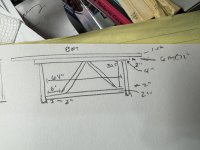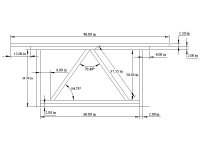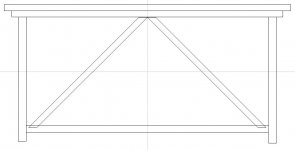onocoffee
Member
Okay, finally I got a pic to successfully post!
I'm working on a project that's utilizing an 8 foot live edge bar top that's about 18" deep. Want to build a wood base for it with 2"x2" structure. I'm thinking that the support under the top should be 6ft long and 2"w x 4"h (does this sound reasonable?). The legs will be framed 2"x2" and a lower crossbar with angled supports. I'm trying to figure out how long the angled supports might be (and figure that can find the right length as it's being assembled.
Overall height from floor to the bar top should be no more than 38".
At the moment, I'm trying to understand how long everything should be, and what dimensions they should be, in order to calculate how much lumber I will need. Apologies for the poor drawing. The inspiration for this frame is from Ishitani Furniture:
I would like to mimic the design of the frame, sans the verticals that go through the top and with Dominos to do the joinery.
This will be my most ambitious project to date. The top is pretty much completed and is 1.5" thick white oak that was from a 180 year old tree that fell in our neighborhood three years ago.
I'm pretty inexperienced and have tried to be as inclusive as possible but I don't know enough to know what to ask or what other considerations I need to keep in mind.
And I should add that while the top is white oak, I'm open to other woods for the frame lumber. I've got a very well-stocked lumber supplier not too far from me.
Thanks!
View attachment 1
I'm working on a project that's utilizing an 8 foot live edge bar top that's about 18" deep. Want to build a wood base for it with 2"x2" structure. I'm thinking that the support under the top should be 6ft long and 2"w x 4"h (does this sound reasonable?). The legs will be framed 2"x2" and a lower crossbar with angled supports. I'm trying to figure out how long the angled supports might be (and figure that can find the right length as it's being assembled.
Overall height from floor to the bar top should be no more than 38".
At the moment, I'm trying to understand how long everything should be, and what dimensions they should be, in order to calculate how much lumber I will need. Apologies for the poor drawing. The inspiration for this frame is from Ishitani Furniture:
I would like to mimic the design of the frame, sans the verticals that go through the top and with Dominos to do the joinery.
This will be my most ambitious project to date. The top is pretty much completed and is 1.5" thick white oak that was from a 180 year old tree that fell in our neighborhood three years ago.
I'm pretty inexperienced and have tried to be as inclusive as possible but I don't know enough to know what to ask or what other considerations I need to keep in mind.
And I should add that while the top is white oak, I'm open to other woods for the frame lumber. I've got a very well-stocked lumber supplier not too far from me.
Thanks!
View attachment 1




